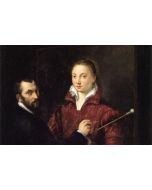Sanctuary in the city – public art by refugees and immigrants
- Course Code: VB975
- Dates: 04/06/24 - 04/06/24
- Time: 11:00 - 13:30
- Taught: Tue, Daytime
- Duration: 1 session
- Location: Off Site
- Tutor: Marilyn Greene
Course Code: VB975
Duration: 1 session
Please note: We offer a wide variety of financial support to make courses affordable. Just visit our online Help Centre for more information on a range of topics including fees, online learning and FAQs.
What is the course about?
This is an exploration walking across the City of London from Aldgate to the Barbican taking in public art by refugees and immigrants from 17th century to the work of contemporary artists. It shows how the City has historically welcomed art by artists who were not British born. Some craftsmen, such as Caius Gabrielle Cibber, was Danish born and came to Britain where in the City he created reliefs on The Monument and St Paul’s Cathedral. Boris Arup became the best-known mosaic artist in mid 20th century Britain and his mosaics line the entrance hall to the National Gallery as well as examples that he made Bank of England buildings in the City. He’d come from an aristocratic Russian family and never returned to Russia after the Russian Revolution. Other sculptors such as Naomi Blake, Frank Meisler and Georg Eirlich came at different stages of their lives from Nazi Europe as Jewish refugees. Some had harrowing personal stories which will be revealed during the course. Out final sculptor, Ivan Klapaz came as a refugee from Croatia in the 1980s during the Yugoslavian wars.
What will we cover?
• Sculptures and public art in the City of London
• The stories of the artists who made the art works
• About immigration and diversity and how the City at various times has welcomed artworks by people not born in Britain.
What will I achieve?
By the end of this course you should be able to...
• Discuss public art in the City giving at least 2 examples covered in the course
• Describe the lives of at least two of the artists
• Identify 2 art works were made by immigrants and 3 made by refugees.
What level is the course and do I need any particular skills?
This course is suitable for all levels.
You should be able to follow simple written and verbal instructions, demonstrations, hand-outs and health and safety information, and will be invited to take part in group discussion.
How will I be taught, and will there be any work outside the class?
You will be taught through lecture outside in front of monuments and spaces pertaining to the topic of this course.
This course takes place offsite in and around London. Offsite courses take place during public access hours. Tutors are not able to control sound levels or behaviours of visitors outside of the course group, gallery closures or fire alarms. Unless you are a wheelchair user, and have confirmed access details with us (as levels of access can vary between buildings), you will need to be able to walk between sites and stand for some time while looking at them (you may bring your own portable stool if you have one, but we cannot guarantee access to seating offsite.) If you feel you may be impacted by these environmental variations, please inform the department on humanities@citylit.ac.uk before the course begins, to discuss reasonable accommodations we can make to assist your learning in offsite.
Are there any other costs? Is there anything I need to bring?
You might wish to purchase a notebook for taking notes. You might wish to buy some of the books on any reading list provided.
When I've finished, what course can I do next?
Art and Refugees in Hampstead
Constable’s Hampstead.
Marilyn Greene is a museum professional and London tour guide with an academic background in art history. Qualified as a City of London Guide, she leads Mud-larking tours, Hidden London Tours for London Transport Museum, school tours at the Charles Dickens Museum, as well as developing her walks in the City and north London. Having worked as a Curator at Hampstead Museum and a qualified City of London guide many of her walks specialise in various aspects of these areas. Marilyn worked for 15 years at the Victoria and Albert Museum in adult and community learning and specialised in working with faith communities and organising intercultural tours of the collections. As well as walking tours, Marilyn leads tours and training at both the Victorian and Albert Museum and British Museum.
Please note: We reserve the right to change our tutors from those advertised. This happens rarely, but if it does, we are unable to refund fees due to this. Our tutors may have different teaching styles; however we guarantee a consistent quality of teaching in all our courses.
